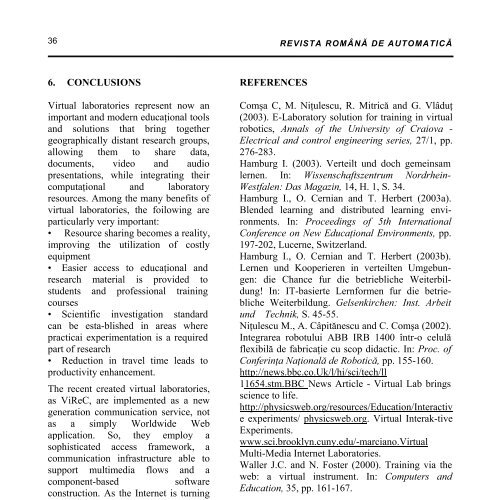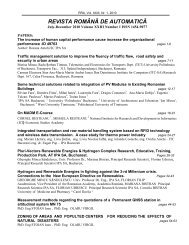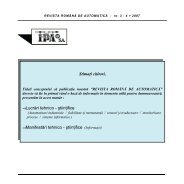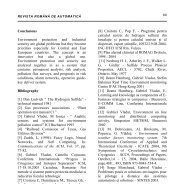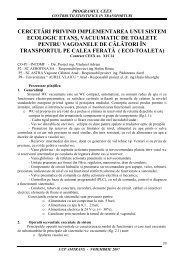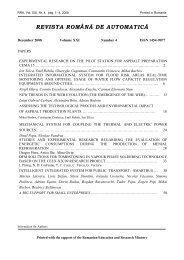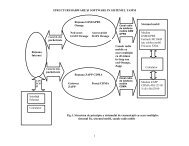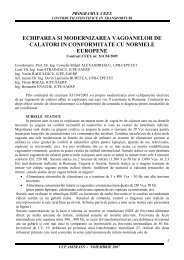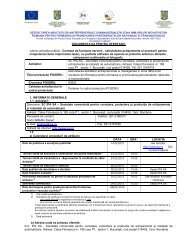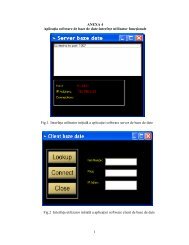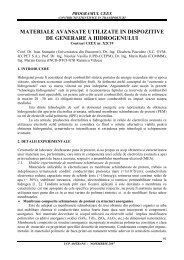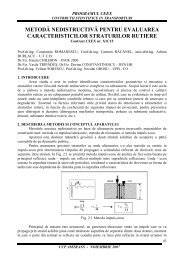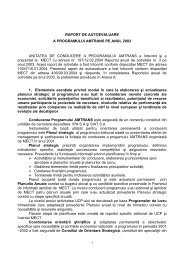Part II - IPA SA
Part II - IPA SA
Part II - IPA SA
Create successful ePaper yourself
Turn your PDF publications into a flip-book with our unique Google optimized e-Paper software.
36 REVISTA ROMÂN DE AUTOMATIC<br />
6. CONCLUSIONS<br />
Virtual laboratories represent now an<br />
important and modern educaional tools<br />
and solutions that bring together<br />
geographically distant research groups,<br />
allowing them to share data,<br />
documents, video and audio<br />
presentations, while integrating their<br />
computaional and laboratory<br />
resources. Among the many benefits of<br />
virtual laboratories, the foilowing are<br />
particularly very important:<br />
• Resource sharing becomes a reality,<br />
improving the utilization of costly<br />
equipment<br />
• Easier access to educaional and<br />
research material is provided to<br />
students and professional training<br />
courses<br />
• Scientific investigation standard<br />
can be esta-blished in areas where<br />
practicai experimentation is a required<br />
part of research<br />
• Reduction in travel time leads to<br />
productivity enhancement.<br />
The recent created virtual laboratories,<br />
as ViReC, are implemented as a new<br />
generation communication service, not<br />
as a simply Worldwide Web<br />
application. So, they employ a<br />
sophisticated access framework, a<br />
communication infrastructure able to<br />
support multimedia flows and a<br />
component-based<br />
software<br />
construction. As the Internet is turning<br />
into a truly multi-service network with<br />
a steady increase in bandwidth and<br />
decrease in response time, the<br />
environment becomes more suitable for<br />
implement-tations such as Virtual<br />
Laboratories.<br />
Furthermore, it offers various<br />
communication channels such as<br />
gestures, voice, and text chat, that help<br />
learners to interact and cooperate with<br />
each other.<br />
REFERENCES<br />
Coma C, M. Niulescu, R. Mitric and G. Vlâdu<br />
(2003). E-Laboratory solution for training in virtual<br />
robotics, Annals of the University of Craiova -<br />
Electrical and control engineering series, 27/1, pp.<br />
276-283.<br />
Hamburg I. (2003). Verteilt und doch gemeinsam<br />
lernen. In: Wissenschaftszentrum Nordrhein-<br />
Westfalen: Das Magazin, 14, H. 1, S. 34.<br />
Hamburg I., O. Cernian and T. Herbert (2003a).<br />
Blended learning and distributed learning environments.<br />
In: Proceedings of 5th International<br />
Conference on New Educaional Environments, pp.<br />
197-202, Lucerne, Switzerland.<br />
Hamburg I., O. Cernian and T. Herbert (2003b).<br />
Lernen und Kooperieren in verteilten Umgebungen:<br />
die Chance fur die betriebliche Weiterbildung!<br />
In: IT-basierte Lernformen fur die betriebliche<br />
Weiterbildung. Gelsenkirchen: Inst. Arbeit<br />
und Technik, S. 45-55.<br />
Niulescu M., A. Câpitnescu and C. Coma (2002).<br />
Integrarea robotului ABB IRB 1400 într-o celul<br />
flexibil de fabricaie cu scop didactic. In: Proc. of<br />
Conferina Naional de Robotic, pp. 155-160.<br />
http://news.bbc.co.Uk/l/hi/sci/tech/ll<br />
11654.stm.BBC News Article - Virtual Lab brings<br />
science to life.<br />
http://physicsweb.org/resources/Education/Interactiv<br />
e experiments/ physicsweb.org. Virtual Interak-tive<br />
Experiments.<br />
www.sci.brooklyn.cuny.edu/-marciano.Virtual<br />
Multi-Media Internet Laboratories.<br />
Waller J.C. and N. Foster (2000). Training via the<br />
web: a virtual instrument. In: Computers and<br />
Education, 35, pp. 161-167.<br />
AR934-7.doc


